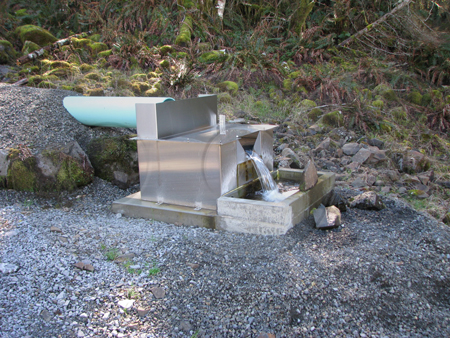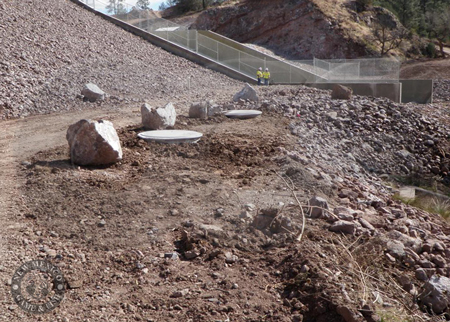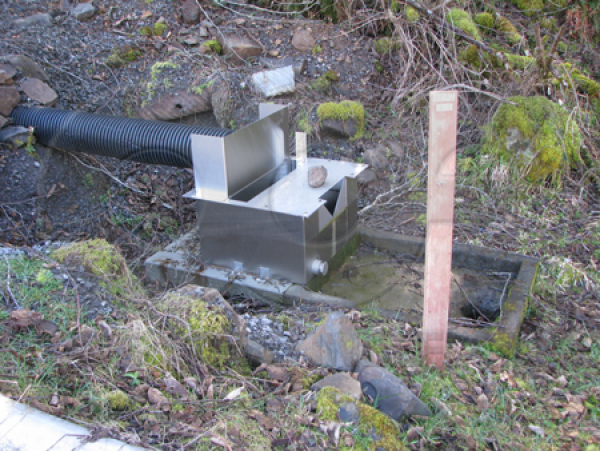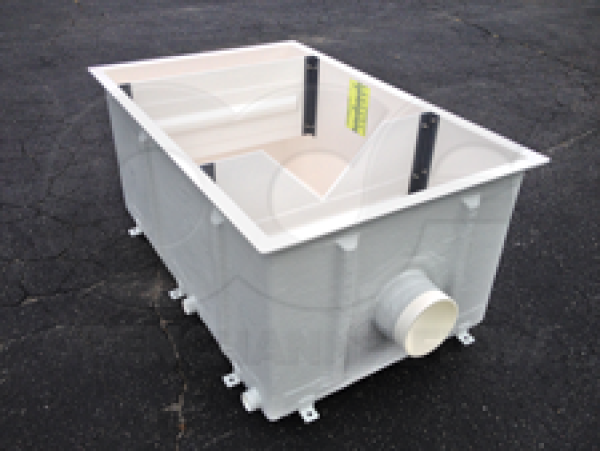This website uses a variety of cookies, which you consent to if you continue to use this site. You can read our Privacy Policy for
details about how these cookies are used, and to grant or withdraw your consent for certain types of cookies.
Measuring Dam Seepage with Weirs and Flumes
Seepage through, below, or around an embankment dam is a critical indicator of the health and condition of the dam.
The amount of seepage is normally directly related to the water level in the reservoir. However, any sudden change in the amount of seepage without an apparent cause – such as a change in reservoir level or rainfall – could indicate a problem with the dam.
Likewise, when the seepage collected contains an increased amount of sediment, experiences a change in its chemical profile, or takes on a different or unusual appearance, a problem with the dam is most likely.
Finally, unusual moisture or water that appears in new or unanticipated locations on the downstream face or below the dam also may indicate a problem.
The devices typically used to quantify seepage are thin-plate weirs and short-throated flumes. When installed correctly, these devices provide accurate, repeatable flow measurement with little maintenance required. Of the two devices, weirs provide better sediment retention than flumes – which are designed to readily pass flows. However, proper weir installation can require a considerable upstream footprint to develop a proper weir pool.
Thin-Plate Weirs
The thin-plate weir is a relatively simple device to construct and, assuming it has been properly sized, can provide field device accuracies of +/- 2-5%. Thin-plate weirs are available in a number of styles:
- V-notch
- Cipolletti
- Rectangular (with and without contractions)
Within each style, there are a number of different standard sizes. It is usually possible, therefore, to select a weir style / size configuration that fits the anticipated seepage rate. For applications where the seepage rate may vary widely, compound weirs may also be used – with each weir section optimized to measure a specific flow range.

While weirs are easy to construct and use, particular care must be taken to ensure that the crest of the weir – the surface over which the seepage will flow – is keep clean, free of debris, and in good repair. Growth or damage to the weir crest can dramatically affect how the seepage will flow over the crest, which will in turn affect system accuracy. To minimize the potential for damage, weirs should be constructed of stainless steel where possible.
Short -Throated Flumes
Short-throated flumes are specially shaped hydraulic devices trough which flow is directed through. The flumes use a change in width, floor height, or a combination of the two to develop a known level-to-flow relationship. Short-throated flumes can be expected to provide installed accuracies of +/- 3-5%.

As with thin-plate weirs, short-throated flumes are available in a number of different styles:
Each flume style is also available in a variety of sizes, so, as with the thin-plate weir, it is usually possible to select a short-throated flume that encompasses all of the anticipated seepage flows. For those applications where no one flume can accommodate the entire range of flumes – current or future – nested (or dual range) flumes can be constructed. These flumes are usually of the same type (e.g. Parshall in a Parshall), but this is not strictly necessary and flumes of dissimilar type can be nested (e.g. Trapezoidal in a Parshall).
Packaged Metering Manholes
Typically dam seepage collection systems are at or slightly below grade – allowing the direct installation of a weir or flume to measure the flows. For those applications where the seepage collection lines are below grade, Packaged Metering Manholes integrating weirs or flumes can be used.
A Packaged Metering Manhole factory integrates the primary device directly into a fiberglass manhole. The result is a single-piece, corrosion resistant, monolithic structure that arrives on site ready for immediate installation. Packaged Metering Manholes eliminates the need to construct underground vaults or chambers to mount the primary device.

As mentioned above, Packaged Metering Manholes can be fabricated with both weirs and flumes integrated into them. However, due to weir pool sizing requirements, Packaged Metering Manholes can only accommodate weirs of small and medium size. For larger flow rates, flumes would need to be integrated in Packaged Metering Manholes as their installation footprint is considerably smaller than a comparably sized weir.
Overall System Accuracy
Keep in mind that will device accuracies for weirs and flumes are listed at +/- 2-5% and +/- 3-5% respectively, overall system accuracies for open channel flow measurement are usually +/- 10% when all factors are considered. Should system accuracies greater than this be desired, the seepage collection system will need to be a closed pipe system – where the piping always runs full.
Related Blog Posts
Explore more insights in our blog.

LOCATIONS IN ATLANTA, GA & BOISE, ID




